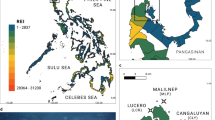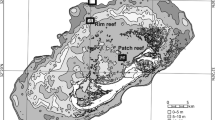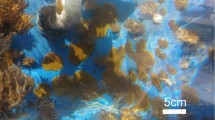Abstract
We have investigated the relationship between genotypic diversity, the mode of production of brooded larvae and disturbance in a range of reef habitats, in order to resolve the disparity between the reproductive mode and population structure reported for the brooding coral Pocillopora damicornis. Within 14 sites across six habitats, the ratio of the observed (G o) to the expected (G e) genotypic diversity ranged from 69 to 100% of that expected for random mating. At three other sites in two habitats the G o /G e ranged from 35 to 53%. Two of these sites were recently bleached, suggesting that asexual recruitment may be favoured after disturbance. Nevertheless, our data suggest that brooded larvae, from each of five habitats surveyed, were asexually produced. While clonal recruitment may be important in disturbed habitats, the lack of clonality detected, both in this and earlier surveys of 40 other sites, implies that a disturbance is normally insufficient to explain this species’ continued investment in clonal reproduction.



Similar content being viewed by others
References
Ayre DJ (1984) The effects of sexual and asexual reproduction on geographic variation in the sea anemone Actinia tenebrosa. Oecologia 62:222–229
Ayre DJ, Dufty S (1994) Evidence for restricted gene flow in the viviparous coral Seriatopora hystrix on Australia Great Barrier Reef. Evolution 48:1183–1201
Ayre DJ, Hughes TP (2000) Genotypic diversity and gene flow in brooding and spawning corals along the Great Barrier Reef, Australia. Evolution 54:1590–1605
Ayre DJ, Hughes TP, Standish RS (1997) Genetic differentiation, reproductive mode, and gene flow in the brooding coral Pocillopora damicornis along the Great Barrier Reef, Australia. Mar Ecol Prog Ser 159:175–187
Ayre DJ, Miller KJ (2004) Where do clonal larvae go? Adult genotypic diversity conflicts with reproductive effort in the brooding coral Pocillopora damicornis. Mar Ecol Prog Ser 277:95–105
Ayre DJ, Veron JEN, Dufty SL (1991) The corals Acropora palifera and Acropora cuneata are genetically and ecologically distinct. Coral Reefs 10:13–18
Baird AH, Marshall PA (1998) Mass bleaching of corals on the Great Barrier Reef. Coral Reefs 17:376
Bell G (1982) The masterpiece of nature: the evolution and genetics of sexuality. Croom Helm, London
Benzie JAH, Haskell A, Lehman H (1995) Variation in the genetic composition of coral (Pocillopora damicornis and Acropora palifera) populations from different reef habitats. Mar Biol 121:731–739
Black R, Johnson MS (1979) Asexual viviparity and population genetics of Actinia tenebrosa. Mar Biol 53:27–31
Booth DJ, Beretta GA (2002) Changes in a fish assemblage after a coral bleaching event. Mar Ecol Prog Ser 245:205–212
Connell JH (1997) Disturbance and recovery of coral assemblages. Coral Reefs 16(Suppl):S101–S113
Connell JH, Hughes TP, Wallace CC (1997) A 30-year study of coral abundance, recruitment, and disturbance at several scales in space and time. Ecol Monogr 67:461–488
Darling JA, Reitzel AM, Finnerty JR (2004) Regional population structure of a widely introduced estuarine invertebrate: Nematostella vectensis Stephenson in New England. Mol Ecol 13:2969–2981
Done TJ (1982) Patterns in the distribution of coral communities across the central Great Barrier Reef. Coral Reefs 1:95–107
Harii S, Kayanne H, Takigawa H, Hayashibara T, Yamamoto M (2002) Larval survivorship, competency periods and settlement of two brooding corals, Heliopora coerulea and Pocillopora damicornis. Mar Biol 141:39–46
Harrison PL, Wallace CC (1990) Coral Reefs. Ecosystems of the world. Elsevier, Amsterdam
Hebert PDN, Ward RD (1976) Enzyme variability in natural populations of Daphnia magna.IV. Ecological differentiation and frequency changes of genotypes at Audley End. Heredity 36:331–341
Hebert PDN, Ward RD, Weider LJ (1988) Clonal diversity patterns and breeding-system variation in Daphnia pulex, an asexual–sexual complex. Evolution 42:147–159
Hebert PN (1978) Adaptive significance of cyclomorphosis in Daphnia: more possibilities. Freshw Biol 8:313–320
Hedrick PW (2000) Genetics of populations. Jones and Bartlett, Boston, MA
Highsmith RC (1982) Reproduction by fragmentation in corals. Mar Ecol Prog Ser 7:207–226
Hoffmann RJ (1986) Variation in contributions of asexual reproduction to the genetic structure of populations of the sea anemone Metridium senile. Evolution 40:357–365
Hughes RN (1989) A functional biology of clonal animals. Chapman and Hall, NY
Hughes TP, Ayre D, Connell JH (1992) The evolutionary ecology of corals. Trends Ecol Evol 7:292–295
Hughes TP, Connell JH (1999) Multiple stressors on coral reefs: a long-term perspective. Limnol Oceanogr 44:932–940
Isomura N, Nishihira M (2001) Size variation of planulae and its effect on the lifetime of planulae in three pocilloporid corals. Coral Reefs 20:309–315
Jackson JBC (1986) Modes of dispersal of clonal benthic invertebrates: consequences for species distributions and genetic structure of local populations. Bull Mar Sci 39(2):588–606
Knowlton N (1993) Sibling species in the sea. Annu Rev Ecol Syst 24:189–216
Knowlton N, Weil E, Weigt LA, Guzman HM (1992) Sibling species in Montastraea annularis, coral bleaching, and the coral climate record. Science 255:330–333
Lasker HR (1990) Clonal propagation and population dynamics of a Gorgonian coral. Ecology 71:1578–1589
Maynard Smith J (1978) The evolution of sex. Cambridge University Press, Cambridge
Miller KJ, Ayre DJ (2004) The role of sexual and asexual reproduction in structuring high latitude populations of the reef coral Pocillopora damicornis. Heredity 92:557–568
Miller KJ, Benzie JAH (1997) No clear genetic distinction between morphological species within the coral genus Platygyra. Bul Mar Sci 61:907–917
Miller MP (1997) Tools for population genetyic analysis (TFPGA) 1.3: A Windows program for the analysis of allozyme and molecular population genetic data. http://www.marksgeneticsoftware.net/tfpga.htm
Nei M (1978) Estimation of average heterozygosity and genetic distance from a small number of individuals. Genetics 89:583–590
Permata WD, Kinzie RA III, Hidaka M (2000) Histological studies on the origin of planulae of the coral Pocillopora damicornis. Mar Ecol Prog Ser 200:191–200
Potts DC (1984) Natural selection in experimental populations of reef-building corals scleractinia. Evolution 38:1059–1078
Raymond M, Rousset F (1995) Genepop (Version 1.2): population genetics software for exact tests and ecumenicism. J Hered 86:248–249
Rice WR (1989) Analyzing tables of statistical tests. Evolution 43:223–225
Richmond RH (1987) Energetics, competence, and long-distance dispersal of planula larvae of the coral Pocillopora damicornis. Mar Biol 93:527–533
Richmond RH, Jokiel PL (1984) Lunar periodicity in larva release in the reef coral Pocillopora damicornis at Enewetak, Marshall slands and Hawaii, USA. Bul Mar Sci 34:280–287
Sebens KP, Thorne BL (1985) Coexistence of clones, clonal diversity, and the effects of disturbance. In: Jackson JBC (ed) Population biology and evolution of clonal organisms. Yale University Press, New Haven, pp 357–398
Selander RK, Smith MH, Yank SY, Johnston WE, Gentry JB (1971) Biochemical polymorphism and systematics in the genus Peromyscus. I. Variation in the old-field mouse (Peromyscus polionotus). Stud Genet 6:49–90
Stoddart JA (1983) Asexual production of planulae in the coral Pocillopora damicornis. Mar Biol 76:279–284
Stoddart JA (1984) Genetic differentiation among populations of the coral Pocillopora damicornis off southwestern Australia. Coral Reefs 3:149–156
Stoddart JA (1988) Coral populations fringing islands larval connections. Aust J Mar Freshw Res 39:109–116
Stoddart JA, Black R (1985) Cycles of gametogenesis and planulation in the coral Pocillopora damicornis. Mar Ecol Prog Ser 23:153–164
Stoddart JA, Taylor JF (1988) Genotypic diversity—estimation and prediction in samples. Genetics 118:705–711
Takabayashi M, Hoegh-Guldberg O (1995) Ecological and physiological differences between two colour morphs of the coral Pocillopora damicornis. Mar Biol 123:705–714
Tanner JE (1996) Seasonality and lunar periodicity in the reproduction of Pocilloporid corals. Coral Reefs 15:59–66
Tunnicliffe V (1981) Breakage and propagation of the stony coral Acropora cervicornis. Proc Natl Acad Sci-Biol 78:2427–2431
Ward S (1992) Evidence for broadcast spawning as well as brooding in the scleractinian coral Pocillopora damicornis. Mar Biol 112:641–646
Weir BS (1979) Inferences about linkage disequilibrium. Biometrics 35:235–254
Weir BS, Cockerham CC (1984) Estimating F-statistics for the analysis of population structure. Evolution 38(6):1358–1370
Williams GC (1975) Sex and evolution. Princeton University Press, Princeton
Wright S (1969) The evolution and genetics of populations, vol 2. The theory of gene frequencies. University of Chicago Press, Chicago, IL
Wright S (1978) Evolution and the genetics of populations. 4. Variability within and among natural populations. University of Chicago Press, Chicago, IL
Wulff JL (1985) Dispersal and survival of fragments of coral reef sponges. Proc 5th Int Coral Reef Congr, Tahiti 5:119–124
Wulff JL (1991) Asexual fragmentation, genotype success, and population dynamics of erect branching sponges. J Exp Mar Biol Ecol 149:227–247
Acknowledgements
We thank Mike Johnson and two anonymous reviewers for comments on the manuscript. M. Martin, J. Dunn and C. Mundy helped with field and laboratory work. K. and P. Beinssen assisted at the University of Sydney’s One Tree Island research station. This work was supported, in part, by two student grants to C.D.H. Sherman by the Great Barrier Reef Marines Park Authority and by an ARC Discovery Grant to D.J. Ayre and K.J. Miller. This is publication #258 from the Ecology and Genetics Group at the University of Wollongong.
Author information
Authors and Affiliations
Corresponding author
Additional information
Communicated by Biological Editor H.R. Lasker
Rights and permissions
About this article
Cite this article
Sherman, C., Ayre, D. & Miller, K. Asexual reproduction does not produce clonal populations of the brooding coral Pocillopora damicornis on the Great Barrier Reef, Australia. Coral Reefs 25, 7–18 (2006). https://doi.org/10.1007/s00338-005-0053-x
Received:
Accepted:
Published:
Issue Date:
DOI: https://doi.org/10.1007/s00338-005-0053-x




